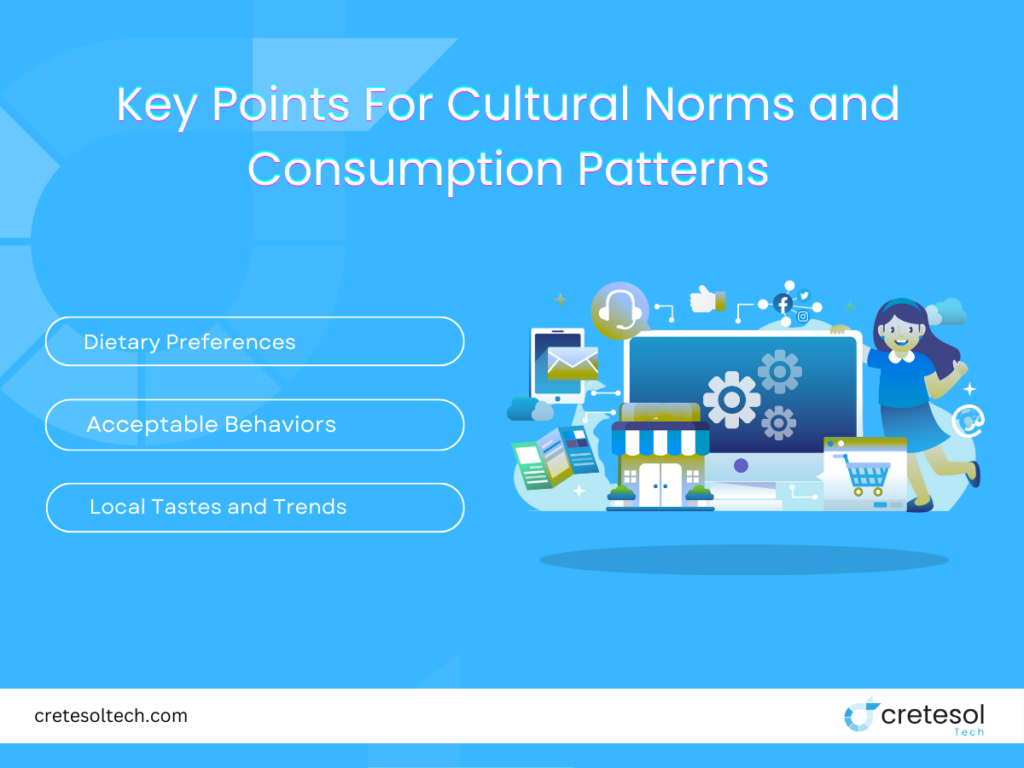A person’s culture plays a significant role in shaping the way they think and act. Due to its effect on the way, people perceive their environment as well as their responsibilities within it and how they choose things, it often determines what makes us patronize different products or services. In this era of globalization, comprehending the impact of culture on consumer behavior globally is important for delivering well successfully. Cultural adaptation in marketing not only enhances marketing approaches but also strengthens relationships with a diverse audience.
Understanding Cultural Influence on Consumer Behavior
Have you ever wondered how cultural influence on consumer behavior shape purchasing decisions? Culture has a significant impact on consumer behavior, influencing tastes, purchase decisions, and brand loyalty. Cultural variables such as values, beliefs, rituals, and traditions have a huge impact on how customers perceive products and companies.
Businesses that are aware of, and appreciate cultural variation in society might want to adjust their marketing efforts accordingly as a way of connecting more effectively with their desired customer base. This will enable them to generate more revenue from such marketing campaigns as well as establish strong consumer contacts that are characterized by increased loyalty and satisfaction.
Cultural Dimensions and Consumer Preferences
Customer preferences are significantly affected by cultural factors. In individualistic cultures, self-expression and personal achievements might be encouraged while community and peace have more value for collectivist cultures.
Understanding these cultural adaptations in marketing aspects enables organizations to design products, services, and marketing messages that are consistent with the cultural values of their target markets, increasing consumer engagement and happiness.
Cultural dimensions, such as individualism vs. collectivism, power distance, and uncertainty avoidance, greatly influence consumer preferences. For instance:
Individualism vs. Collectivism
In individualistic civilizations, consumers may value personal accomplishments and self-expression, preferring items that emphasize individuality and success. In contrast, customers in collectivist cultures may value community, harmony, and family, preferring items that stress group advantages and social harmony.
Power Distance
Cultures with a high power distance are more accepting of hierarchical order and unequal power distribution. Consumers in these societies may select brands that communicate status and distinction. Consumers in low power distance societies, where equality and collaborative decision-making are valued, may prefer products that encourage egalitarianism and inclusivity.
Uncertainty Avoidance
Cultures that prioritize uncertainty avoidance have a long time of insecurity and risk. Consumers in these cultures may like popular brands that they trust and feel safe using. Cultures with low uncertainty avoidance, on the other hand, are more open to risk and innovation, often preferring cutting-edge products and novel experiences.
Learn more about Cross Cultural Communication in Global Marketing.
The Role of Subcultures in Consumer Behavior
Subcultures, defined by criteria such as race, religion, or geographic region, also have a significant impact on consumer behavior. These groups have diverse interests, values, and buying behaviors, which can have a big impact on their purchasing decisions.
Marketers who can comprehend these subcultures tend to make advertising that is more focused and relevant, hence increasing the chances of their message reaching some specific audiences. Brands that personalize marketing strategies to the unique attributes of separate subcultures are able to create stronger links, to encourage more commitment to brands as well as move their goods successfully.
Cultural Norms and Consumption Patterns
Cultural adaptation in marketing and cultural norms govern acceptable actions and consumption patterns within a society. These standards influence how people live, what they value, and eventually what they buy. Dietary tastes, for example, might change greatly between cultures, impacting the types of food products popular in different locations.
Understanding cross cultural communication in global marketing by knowing cultural norms is critical for marketers to avoid cultural faux pas and guarantee their products are appropriate for local tastes. Businesses that are culturally sensitive can develop more effective marketing tactics that appeal to their target clientele.
Key Points
Dietary Preferences: Dietary Preferences: Different cultures have distinct dietary patterns that influence the appeal of particular food items. To flourish in varied marketplaces, marketers must tailor their goods to these preferences.
Acceptable Behaviors: What is deemed acceptable conduct differs by culture, which influences how things are used and promoted. Understanding these characteristics assists in creating relevant marketing messaging.
Local Tastes and Trends: Paying attention to local tastes and trends allows marketers to create products and campaigns that directly appeal to the cultural norms of a given place, increasing engagement and sales.

Adapting Marketing Strategies to Cultural Differences
Cultural adaptation in marketing includes tailoring marketing methods to the cultural environment of each target market. This approach, known as “Adapting Marketing Strategies to Cultural Differences,” is critical for worldwide companies seeking to interact with varied consumers. To guarantee that marketing activities are effective, it is necessary to have a thorough awareness of local cultures, values, and customer behaviour.
Altering Advertising Messages: Different cultures have unique values and communication approaches. Effective cultural adaptation in marketing entails adjusting advertising messages to suit these variances. Humor, images, and language that are effective in one country may be inappropriate or ineffective in another. Businesses can better communicate with their target audience by tailoring messages to cultural norms.
Modifying Packaging: Packaging is another crucial factor that requires adaption. Colors, symbols, and even the size and shape of packaging can have diverse meanings across cultures. For example, while white may represent purity in some cultures, it is connected with sadness in others. Businesses can increase the attractiveness and acceptability of their products by modifying packaging to reflect local Cultural Considerations in global marketing.
Adjusting the Product: The product itself may need to be modified to fit local tastes and preferences. This could include changing the components in a food product, modifying the functions of a technological device, or personalizing clothing trends. By adapting marketing strategies to cultural differences, cultural adaptation in marketing and understanding local consumer wants and preferences enables firms to provide products that better satisfy the expectations and aspirations of their target market.
Explore more about How Cultural Adaptation Enhances Global Marketing Campaigns
Cultural Sensitivity in Marketing Communications
Cultural sensitivity is crucial for effective marketing communications. This includes not just understanding cultural differences, but also being courteous and cautious in the manner messages are written and delivered. Culturally inappropriate advertising can cause controversy and undermine a brand’s reputation. Here are some important aspects to consider when preserving cultural sensitivity in marketing communications:
Understanding Cultural Differences: Conduct extensive research about your target market’s cultural norms, values, and traditions. This includes linguistic variances, social norms, and behavioral expectations. Understanding these variations enables marketers to create messages that resonate positively with their target group.
Respectful Messaging: It is necessary to design communications that respect and understand the audience’s cultural adaptation in marketing. Avoid using stereotypes and cultural clichés that may offend or misrepresent the target demographic. Respectful marketing respects the audience’s cultural identity while also demonstrating the brand’s commitment to diversity.
Thoughtful Delivery: How a message is delivered can be just as important as its content. This includes choosing the proper channels, timing, and tone. Humor or language that is effective in one culture may not work well in another. Thoughtful delivery ensures that the message is received in the appropriate spirit and context.
Conclusion
Understanding cultural adaptation in marketing and how cultural impact influences consumer behavior is critical for any organization trying to succeed in the global market. Continuous cultural research and adaptation are essential components of successful marketing strategy.
Cretesol Tech offers specialized assistance in building culturally sensitive and effective marketing strategies. Our experienced personnel are eager to assist your company in expanding into new areas.
FAQs
What are the main cultural factors that influence consumer behavior?
Cultural factors include values, beliefs, language, traditions, and social norms. These factors shape how consumers perceive products and brands, and ultimately, their purchasing decisions.
How can businesses effectively tailor their marketing messages to different cultures?
Businesses can tailor their marketing messages by conducting thorough cultural research, understanding local preferences and sensitivities, and adapting their communications to align with cultural norms and values.
What tools can help with conducting cultural market research?
Tools such as surveys, focus groups, ethnographic studies, and data analytics can provide valuable insights into cultural preferences and behaviors. Additionally, collaborating with local experts can enhance the accuracy and relevance of the research.

 United Arab Emirates
United Arab Emirates